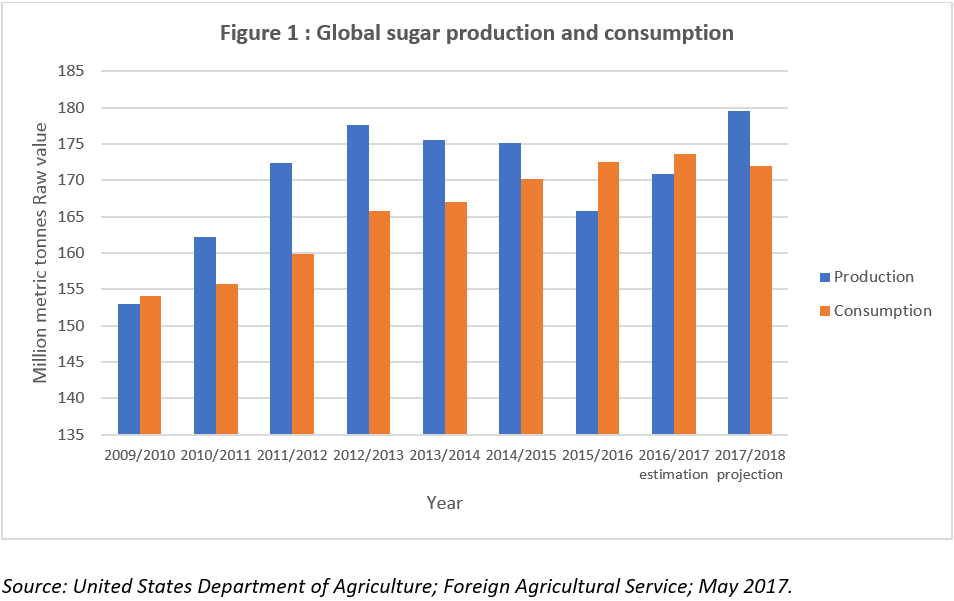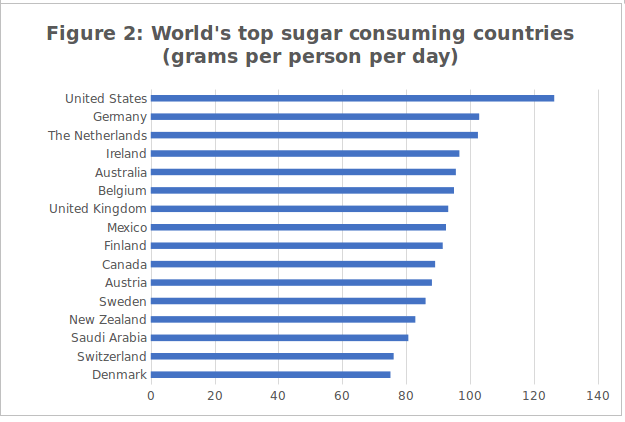Overview
Addressing the Global Need to Reduce Added Sugar in the Diet
Globally, sugar consumption has been increasing steadily over the past several years (Figure 1). The United States is the world’s biggest consumer of sugar with an average per capita intake of 126.4 gm of sugar daily or the equivalent of 31.6 teaspoons.


Numerous regulatory agencies and public health organizations have issued specific guidelines for reducing added sugar in the diet to help address the rise in obesity, as well as other diseases related to excess sugar intake, such as cardiovascular disease, hypertension, obesity-related cancers, diabetes and dental caries, with most of these recommendations calling for limit calories from added sugars to no more than 10% each day, or about 12 teaspoons.
Plant-based, zero calorie stevia can be part of a well-balanced diet to help reduce energy and added sugar intake without sacrificing taste. Stevia is safe for people with diabetes as it does not contain any calories or carbohydrates and therefore does not affect blood glucose or insulin levels. Stevia is also safe for children and pregnant or nursing moms.
Stevia leaves naturally contain sweet compounds called steviol glycosides. High purity stevia leaf extract, the ingredient form approved for food and beverage by regulatory authorities, contains 95% or more of these steviol glycosides. It is this high purity form that has been rigorously tested in more than 200 scientific studies and approved for human consumption by multiple major regulatory organizations around the globe.
| Regulatory Body | Added Sugar Dietary Guidance | Reference |
|---|---|---|
| World Health Organization | Reduce the intake of free sugars to less than 10% of total energy intake, with a further reduction to below 5% or roughly 25 grams (six teaspoons) per day for additional health benefits | World Health Organization (WHO). Guideline: Sugars Intake for Children and Adults. Geneva: WHO, 2015 http://www.who.int/nutrition/publications/guidelines/sugars_intake/en/ |
| Dietary Guidelines for Americans | Limit calories from added sugars to no more than 10% each day, which is 200 calories, or about 12 teaspoons, for a 2,000 calorie diet. | U.S. Department of Health and Human Services and U.S. Department of Agriculture. 2015–2020 Dietary Guidelines for Americans. 8th Edition. December 2015. |
| Public Health England (PHE) | Restrict free sugars consumption to less than 5% of the total energy intake | SACN (Scientific Advisory Committee on Nutrition) (2015) Carbohydrates and Health. |
| American Heart Association | Limit added sugars to no more than half of your daily discretionary calories allowance.
| Dietary Sugars Intake and Cardiovascular Health A Scientific Statement From the American Heart Association.Circulation. 2009; 120:1011-1020Added Sugars and Cardiovascular Disease Risk in Children. A Scientific Statement from the American Heart Association. Circulation. 2017 May 9; 135(19): e1017–e1034. |
| European Food Safety Authority | Will come out with added sugar recommendations in 2020 | EFSA to give advice on the intake of sugar added to food |
| International Diabetes Federation, Europe | Limit consumption of foods and drinks containing high amounts of sugars (e.g. sugar-sweetened beverages, sugary snacks and candies) and eating fresh fruits and raw vegetables as snacks instead of sugary snacks | IDF EUROPE POSITION ON ADDED SUGAR April 2016 |
| World Cancer Research Federation International | Recommends a comprehensive approach to reducing sugar consumption cross all three policy domains outlined in their NOURISHING framework: food environment, food system and behaviour change communication. | I‘Curbing global sugar consumption: Effective food policy actions to help promote healthy diets and tackle obesity’, 2015 |
| Australian Dietary Guidelines | Limit intake of foods and drinks containing added sugars such as confectionary, sugar-sweetened soft drinks and cordials, fruit drinks, vitamin waters, energy and sports drinks. | Eat for Health, Australian Dietary Guidelines Providing the scientific evidence for healthier Australian diets, 2013 |
| Diabetes Canada Position on Sugars |
| Diabetes Canada: Sugars Position Statement 2016 |
| Academy of Nutrition and Dietetics | It is the position of the Academy of Nutrition and Dietetics that consumers can safely enjoy a range of nutritive and nonnutritive sweeteners when consumed within an eating plan that is guided by current federal nutrition recommendations, such as the Dietary Guidelines for Americans and the Dietary Reference Intakes, as well as individual health goals and personal preference. | Position of the Academy of Nutrition and Dietetics: use of nutritive and nonnutritive sweeteners.. J Acad Nutr Diet. 2012 May;112(5):739-58 |
| Chinese Dietary Guidelines | No more than 10% of total calories from added sugar, or 12.5 teaspoons of sugar or less, with a preferred level of no more than 5% of calories or 6.25 teaspoons of sugar. | The Chinese Nutrition Society. The Food Guide Pagoda for Chinese Residents. Available from2016 Dietary Guidelines for Chinese Residents (2016): comments and comparisons Shan-shan Wang, Sovichea Lay, Hai-ning Yu, Sheng-rong Shen J Zhejiang Univ Sci B. 2016 Sep; 17(9): 649–656. |
| ANSES Food consumption guidelines for the French population | Set an upper limit of 100 g/day for total consumption of sugars, excluding lactose and galactose. | Opinion of the French Agency for Food, Environmental and Occupational Health & Safety on the establishment of recommendations on sugar intake https://www.anses.fr/en/system/files/NUT2012SA0186EN.pdf |
| Dietary Guidelines for the Brazilian Population 2014 | Use oils, fats, salt, and sugar in small amounts when seasoning and cooking natural or minimally processed foods and to create culinary preparations. | Dietary guidelines for the Brazilian population (English) (Portuguese) (Spanish) |
| National Institute of Nutrition, India | Minimize the use of processed foods rich in salt, sugar and fats. For prevention of diet-related chronic diseases, sugars and refined cereals should be sparingly used. | Dietary Guidelines for Indians http://ninindia.org/DietaryGuidelinesforNINwebsite.pdf |
REFERENCES
- http://www.worldatlas.com/articles/top-sugar-consuming-nations-in-the-world.html. Accessed September 12 2017

